Brienne 1814 AAR
In early January 1814, Napoleon's weakened forces lost the Rhine barrier and over a quarter of one million allied soldiers began their advance to French soil. After a series of defeats under his blundering marshals, Napoleon decided to take personal command of the remaining French divisions defending Paris--barely 60,000 men. Reinvigorated with his old energy and fire, the Emperor sought to place his army in between the advancing allies, defeating each allied sovereign in detail before they could unite.
On January 28, Blücher and Schwarzenberg were dangerously close to joining forces.
Napoleon pounced on the opportunity and directed his scattered divisions to converge against Blücher at the crossroads of Brienne. Here, fate intervened. Russian Cossacks intercepted some of the Emperor's written orders, which alerted Blücher to the trap. Not only was the wily old Prussian ready for the French attack, the capture of Napoleon's orders meant that his intended reinforcements would not fall on Blücher's exposed flank. Throughout the morning and early afternoon of January 29, French and Russian troops converged at Brienne for battle....
Russian Aim: Check Napoleon’s advance and protect the supply lines to E.
French Aim: Destroy the Russian army.
Brienne-le-chateau and Brienne-le-Vielle are major objectives.
Game Length: 3pm to 7.30pm, 10 turns
Scale 80: Infantry unit=1000 men, Cavalry unit=320 men, Artillery unit=10 guns, 1 mm=3.3 m
Scenario File
Game setup looking from the Russian side of the battlefield (pic below).
Brienne-le-Veille is in the foreground with the Russian line of communication following the road over the River L’Aube. The Russian troops are defending in front of Brienne-le-chateau as the French arrive at the top-right corner.



The French push forward on their left flank as the Russians pull back to the protection of the town.
The French cavalry sweep around to the left flank but they are too slow to effectively support the main attack.
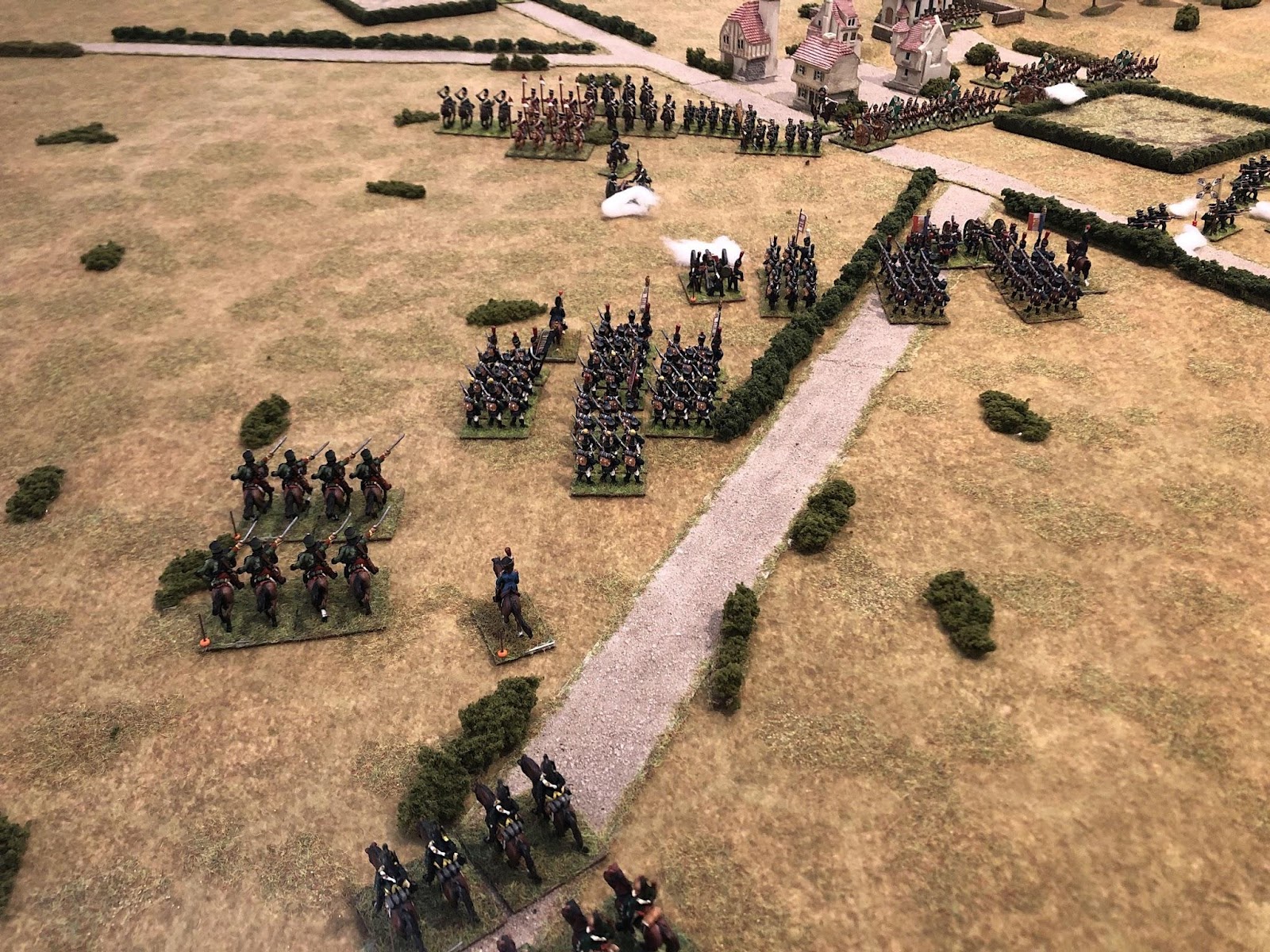
The Russians push a Jager regiment forward to threaten the French artillery and are, in turn, charged by some Guard Lancers suffering heavily but holding their position.

On January 28, Blücher and Schwarzenberg were dangerously close to joining forces.
Napoleon pounced on the opportunity and directed his scattered divisions to converge against Blücher at the crossroads of Brienne. Here, fate intervened. Russian Cossacks intercepted some of the Emperor's written orders, which alerted Blücher to the trap. Not only was the wily old Prussian ready for the French attack, the capture of Napoleon's orders meant that his intended reinforcements would not fall on Blücher's exposed flank. Throughout the morning and early afternoon of January 29, French and Russian troops converged at Brienne for battle....
Russian Aim: Check Napoleon’s advance and protect the supply lines to E.
French Aim: Destroy the Russian army.
Brienne-le-chateau and Brienne-le-Vielle are major objectives.
Game Length: 3pm to 7.30pm, 10 turns
Scale 80: Infantry unit=1000 men, Cavalry unit=320 men, Artillery unit=10 guns, 1 mm=3.3 m
Scenario File
Game setup looking from the Russian side of the battlefield (pic below).
Brienne-le-Veille is in the foreground with the Russian line of communication following the road over the River L’Aube. The Russian troops are defending in front of Brienne-le-chateau as the French arrive at the top-right corner.
Game setup looking from the French side of the battlefield.
Duhesme and Dufours’ Divisions advance on the French left. Milhaud and Desnouettes’ Cavalry Divisions are on the French right.
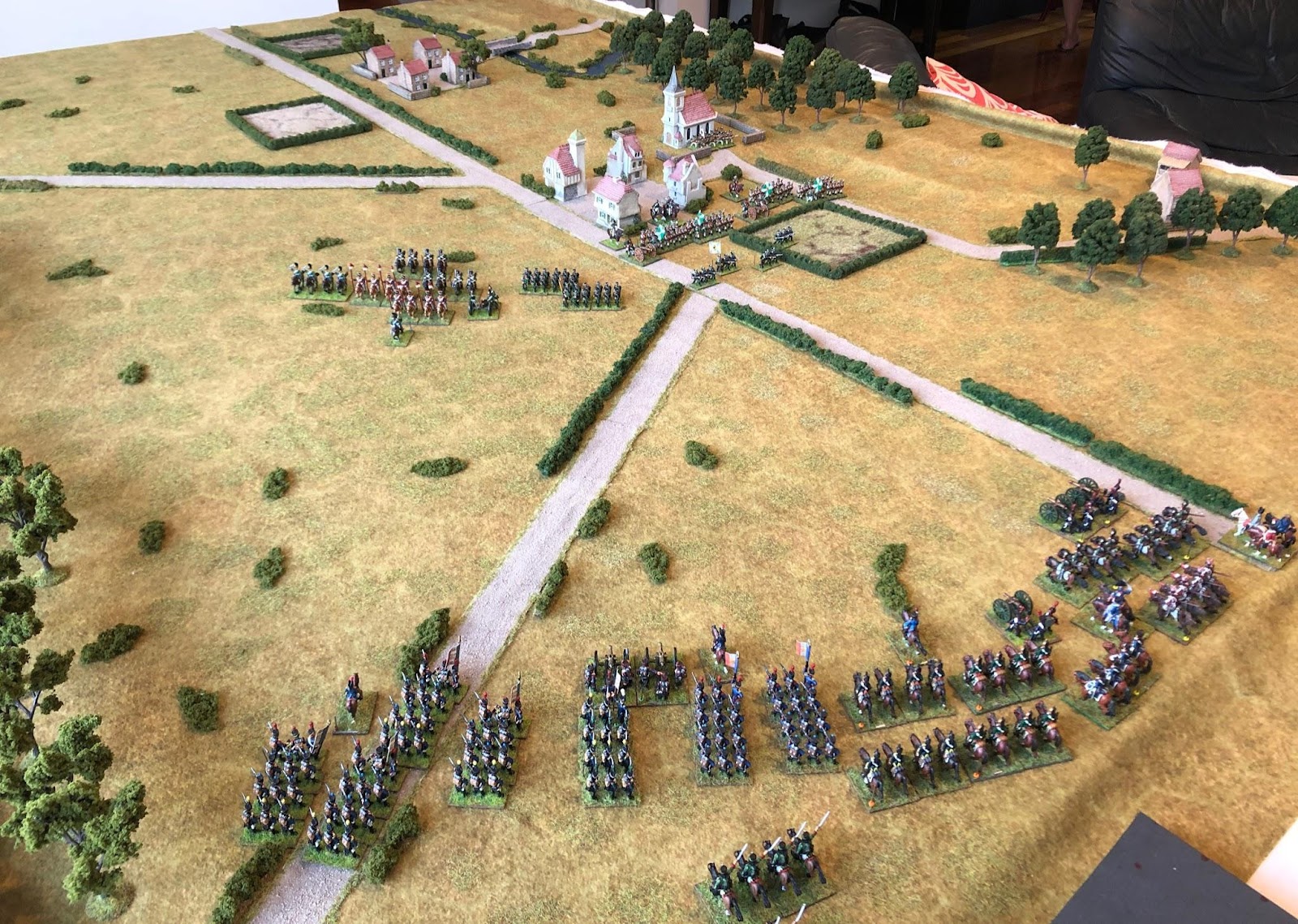
Game setup showing Udom and Karneilov’s Divisions defending the Chateau and the Brienne township. Pahlen’s advance guard sits on the Russian right flank between Brienne and the woods.

Duhesme and Dufours’ Divisions advance on the French left. Milhaud and Desnouettes’ Cavalry Divisions are on the French right.
Game setup showing Udom and Karneilov’s Divisions defending the Chateau and the Brienne township. Pahlen’s advance guard sits on the Russian right flank between Brienne and the woods.
Turn 1
Two French Divisions advance in column towards Brienne.
Milhaud’s cavalry shifts to take up a position on the left flank, covering any threat from Pahlen’s advance guard cavalry on the plain.
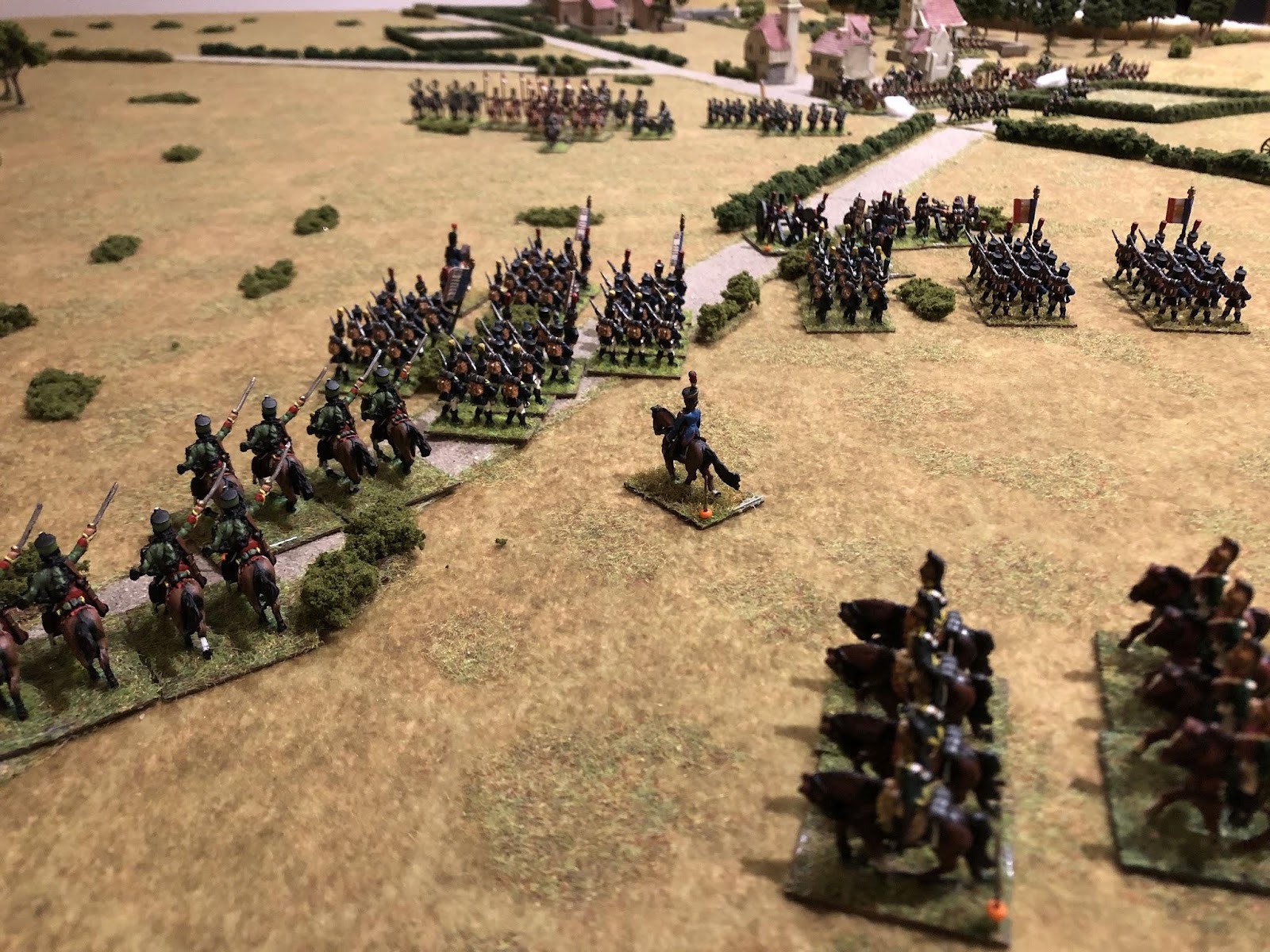

Blucher awaits the inevitable French attack in Brienne-le-chateau.
The Russian artillery opens fire on the French artillery.
Milhaud’s cavalry shifts to take up a position on the left flank, covering any threat from Pahlen’s advance guard cavalry on the plain.
Napoleon directly oversees the guard horse artillery advance into range supported by the guard cavalry.
Blucher awaits the inevitable French attack in Brienne-le-chateau.
The Russian artillery opens fire on the French artillery.
Turn 2
With a some lucky rolls, the 7th and 18th Divisions as well as a Cavalry division all arrive for the Russians on turn 2.
The French push forward on their left flank as the Russians pull back to the protection of the town.
The French cavalry sweep around to the left flank but they are too slow to effectively support the main attack.
The Russians push a Jager regiment forward to threaten the French artillery and are, in turn, charged by some Guard Lancers suffering heavily but holding their position.
Turn 3
The French attack stalls as a counter-attack by Russian cavalry forces the lead unit into square. The Russians are repulsed but the momentum of the attack is stalled.
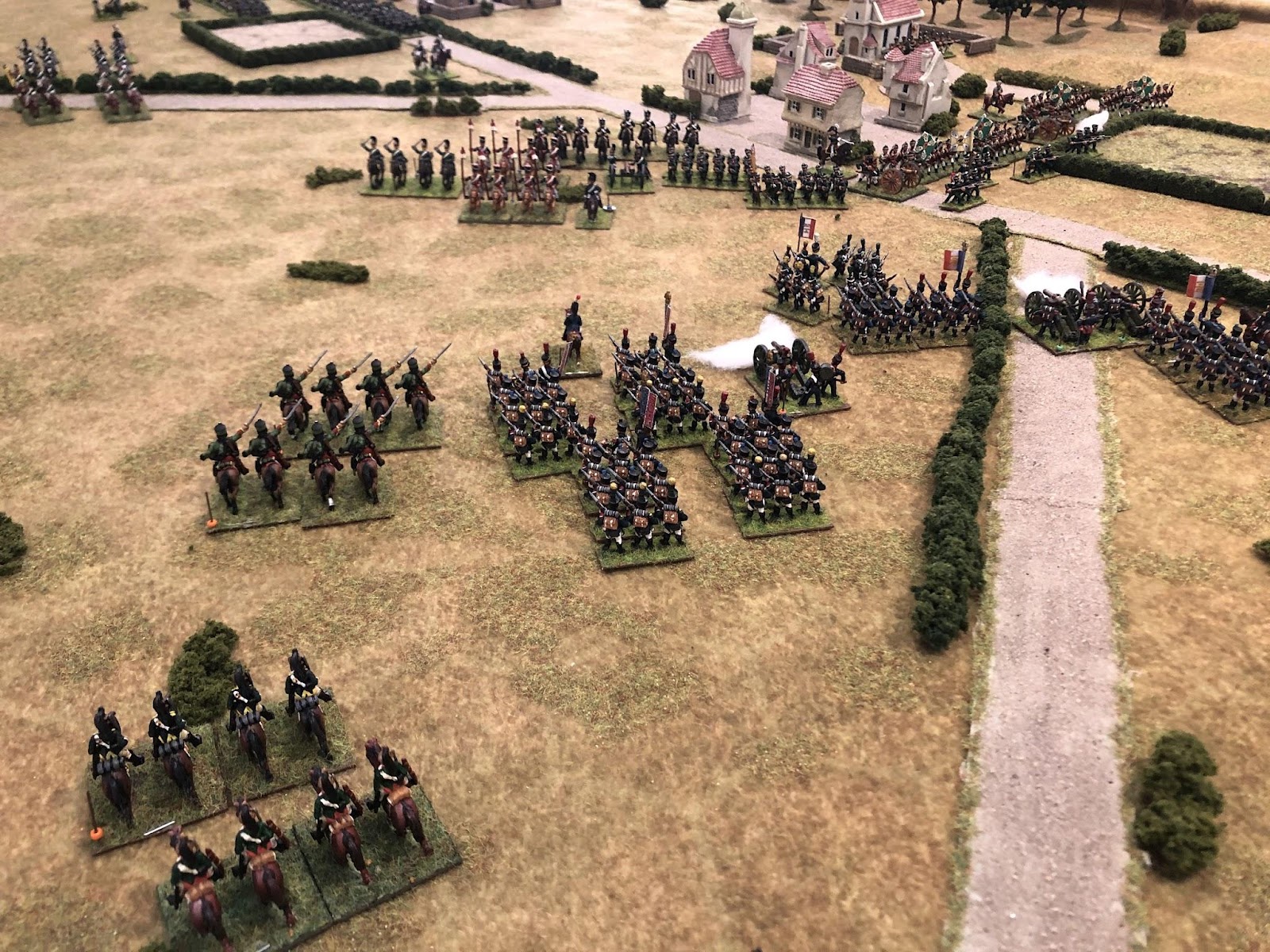
Victor’s Division arrives for the French and they march directly for the Russians defending Brienne.

The Russian position defending Brienne-le-chateau looks quite strong as the French struggle to bring their attack in.

The Russian reinforcements move quickly to support the their colleagues.
The extra cavalry numbers will soon give the Russians a clear advantage on the Russian right flank.

Victor’s Division arrives for the French and they march directly for the Russians defending Brienne.
The Russian position defending Brienne-le-chateau looks quite strong as the French struggle to bring their attack in.
The Russian reinforcements move quickly to support the their colleagues.
The extra cavalry numbers will soon give the Russians a clear advantage on the Russian right flank.
Turn 4
The Russian reinforcements start to deploy on the right flank. The early arrival of these forces is going to make it very difficult for the French to take Brienne-le-chateau.

Russian heavies and cossacks charge onto the battlefield turning the tide of numbers heavily in favour of the Russians.
A brief melee between Russian lancers and French chasseurs (centre of photo) resulted in a victory for the Russians but at a heavy cost as French infantry charged the lancers and they fled back to their lines.

A French Guard Division marches onto the board and quickly swings to the right flank attempting to directly threaten the chateau from the woods.
The Russians in front of Brienne-le-chateau have pulled back to the cover of the town, but a Jager regiment takes the full brunt of an artillery barrage and routes through the town.

View from the French side in the centre of the battlefield. Napoleon watches with some concern as his attack falters. The Russians have pulled back out of artillery range but the arrival of mass Russian troops poses a risk to the French left flank. Thankfully, the second Guard Division arrives on the road at the bottom left and the Guard cavalry have moved to the centre ready to support the left flank. With increasing desperation, a French light cavalry brigade is ordered to the right flank skirting the field in front of Brienne to try and exploit the weaker Russian left flank. They will support the Guard Division also on that flank.

Russian heavies and cossacks charge onto the battlefield turning the tide of numbers heavily in favour of the Russians.
A brief melee between Russian lancers and French chasseurs (centre of photo) resulted in a victory for the Russians but at a heavy cost as French infantry charged the lancers and they fled back to their lines.
A French Guard Division marches onto the board and quickly swings to the right flank attempting to directly threaten the chateau from the woods.
The Russians in front of Brienne-le-chateau have pulled back to the cover of the town, but a Jager regiment takes the full brunt of an artillery barrage and routes through the town.
View from the French side in the centre of the battlefield. Napoleon watches with some concern as his attack falters. The Russians have pulled back out of artillery range but the arrival of mass Russian troops poses a risk to the French left flank. Thankfully, the second Guard Division arrives on the road at the bottom left and the Guard cavalry have moved to the centre ready to support the left flank. With increasing desperation, a French light cavalry brigade is ordered to the right flank skirting the field in front of Brienne to try and exploit the weaker Russian left flank. They will support the Guard Division also on that flank.
Turn 5
View from the Russian side. The Russian reinforcements set up a strong right flank. Their overwhelming cavalry advantage has halted the French attack.
At the bottom left, a Russian Division is redirected off to the left flank to support the Chateau defenders. In the middle-left, two Jager regiments route after suffering heavily from the French artillery.


Looking from Napoleon’s position, the right flank looks more promising. French artillery has pushed back the Russian infantry into the town. The lead French Chasseur regiment took heavy losses from the Russian artillery and routed. However, they have rallied while the second regiment plowed through the Russian battery scattering the crew and capturing the guns. The French Guard have marched at the double out of the woods and along the ridge to move within striking distance of the Chateau. The Russian infantry though, are well entrenched around the Chateau and will be very hard to dislodge.
In the foreground, Victor’s Divisional column marches forward to attack the town centre. At this stage of the battle a lot hinges on the outcome of the cavalry battle on the other flank. Darkness is approaching in 3 turns which will render artillery ineffective and cavalry much weaker.

At the bottom left, a Russian Division is redirected off to the left flank to support the Chateau defenders. In the middle-left, two Jager regiments route after suffering heavily from the French artillery.
A closer look at the Russian right flank with a mass of cavalry. Luckily for the French, the Russian commander rolled poorly and the attack stumbled allowing the French to bring up several dragoon regiments.
Looking from Napoleon’s position, the right flank looks more promising. French artillery has pushed back the Russian infantry into the town. The lead French Chasseur regiment took heavy losses from the Russian artillery and routed. However, they have rallied while the second regiment plowed through the Russian battery scattering the crew and capturing the guns. The French Guard have marched at the double out of the woods and along the ridge to move within striking distance of the Chateau. The Russian infantry though, are well entrenched around the Chateau and will be very hard to dislodge.
In the foreground, Victor’s Divisional column marches forward to attack the town centre. At this stage of the battle a lot hinges on the outcome of the cavalry battle on the other flank. Darkness is approaching in 3 turns which will render artillery ineffective and cavalry much weaker.
Turn 6
The French Guard attack the Chateau but the Russians hold firm. The French Chasseurs continue their rampage, routing a second Russian battery (at top right). The Russians have pulled all their units into the cover of the town and the Chateau. Russian reinforcements are arriving through the woods beside the Chateau.

A massive cavalry battle now rages on the Russian right flank. French and Russian dragoons clash with losses on both sides. The Russian dragoons were caught still in column, but still managed to hold off the French charge. The French have now committed the Guard Cavalry (at top of picture) to support the attack.

The battlefield looking from the French side. The mass cavalry battle can be seen on the left flank, and the Guard infantry attack on the Chateau on the right flank. The French centre however, has stalled, although the arrival of the second Guard Division down the road in the middle of the picture could turn the tide.

A massive cavalry battle now rages on the Russian right flank. French and Russian dragoons clash with losses on both sides. The Russian dragoons were caught still in column, but still managed to hold off the French charge. The French have now committed the Guard Cavalry (at top of picture) to support the attack.
The battlefield looking from the French side. The mass cavalry battle can be seen on the left flank, and the Guard infantry attack on the Chateau on the right flank. The French centre however, has stalled, although the arrival of the second Guard Division down the road in the middle of the picture could turn the tide.
Turn 7
The French Guard continue their assault on the chateau, gradually wearing the Russian infantry down. But there are plenty of Russian reserves on hand.
Victor’s Division also forms up to begin its’ assault on the chateau.

The cavalry melee rages on the French left. Two Russian regiments have routed but the French have also suffered heavy casualties. With night about to fall, all this cavalry will operate as unformed and be restricted to infantry movement rates.


The whole battlefield from the Russian side. The Russians have plenty of troops in and around Brienne, and have neutralised the French cavalry with their own. The French will have to risk heavy casualties to take the town now as darkness begins to fall.

Victor’s Division also forms up to begin its’ assault on the chateau.
The cavalry melee rages on the French left. Two Russian regiments have routed but the French have also suffered heavy casualties. With night about to fall, all this cavalry will operate as unformed and be restricted to infantry movement rates.
View from behind the centre of the French position.The second Guard Division deploys to attack the town.
The whole battlefield from the Russian side. The Russians have plenty of troops in and around Brienne, and have neutralised the French cavalry with their own. The French will have to risk heavy casualties to take the town now as darkness begins to fall.
Turn 8
Darkness falls but the French press home their attack on Brienne-le-chateau.
Two French Guard regiments established a foothold in the chateau, although Russian reserves ousted one of the regiments.
The Guard Division has brought up their own reserves to try and consolidate their hold.
The French have also besieged the town itself on two sides and the Russian defenders are at breaking point.

The view from the Russian right flank. Three Russian cavalry regiments are fleeing the field but the rest stand solidly. The arrival of nightfall means that both sides cavalry will be relatively impotent.

Napoleon (bottom-right) surveys the battle in the dim light. He has sent the Guard in to attack the town and the chateau in a last-ditched effort to retrieve something from the battle. The Russian right flank looks well-entrenched as the French infantry deploy ready to attack.


The attack on the town and chateau from the French side. One Guard regiment is fleeing, but 2 other regiments have established themselves in the chateau and another has forced its’ way into the town (marked by blue rectangles)

View from the French left flank. The lead French brigade flees after attacking the Russian line outside the town. The Russians suffered heavy casualties but their steadfastness was too much for the French.

Two French Guard regiments established a foothold in the chateau, although Russian reserves ousted one of the regiments.
The Guard Division has brought up their own reserves to try and consolidate their hold.
The French have also besieged the town itself on two sides and the Russian defenders are at breaking point.
The view from the Russian right flank. Three Russian cavalry regiments are fleeing the field but the rest stand solidly. The arrival of nightfall means that both sides cavalry will be relatively impotent.
Napoleon (bottom-right) surveys the battle in the dim light. He has sent the Guard in to attack the town and the chateau in a last-ditched effort to retrieve something from the battle. The Russian right flank looks well-entrenched as the French infantry deploy ready to attack.
Turn 9
The French attack on Brienne-le-chateau is starting to wear the Russian defenders down. Five Russian regiments are fleeing the town!
The attack on the town and chateau from the French side. One Guard regiment is fleeing, but 2 other regiments have established themselves in the chateau and another has forced its’ way into the town (marked by blue rectangles)
View from the French left flank. The lead French brigade flees after attacking the Russian line outside the town. The Russians suffered heavy casualties but their steadfastness was too much for the French.
Turn 10
The French close in on the town of Brienne. Only one Russian Jager regiment remains in the township while the French Guard break through to the town centre. The battle for the Chateau is evenly poised but the strength of the French Guard is proving the difference.


View from behind the Russian position. Russian lancers rout at bottom-right while some of the routing Russian infantry have rallied in front of Brienne-le-veille.

The French Guard cavalry push forward in the failing light to keep the pressure on the Russian right flank.
View from behind the Russian position. Russian lancers rout at bottom-right while some of the routing Russian infantry have rallied in front of Brienne-le-veille.
Turn 11
The Russians struggle to hold back the French in the chateau. The French Guard has broken through into the town and a lone Russian jager regiment is now surrounded in the town. In the foreground, two Russian regiments have rallied but many others are routing.





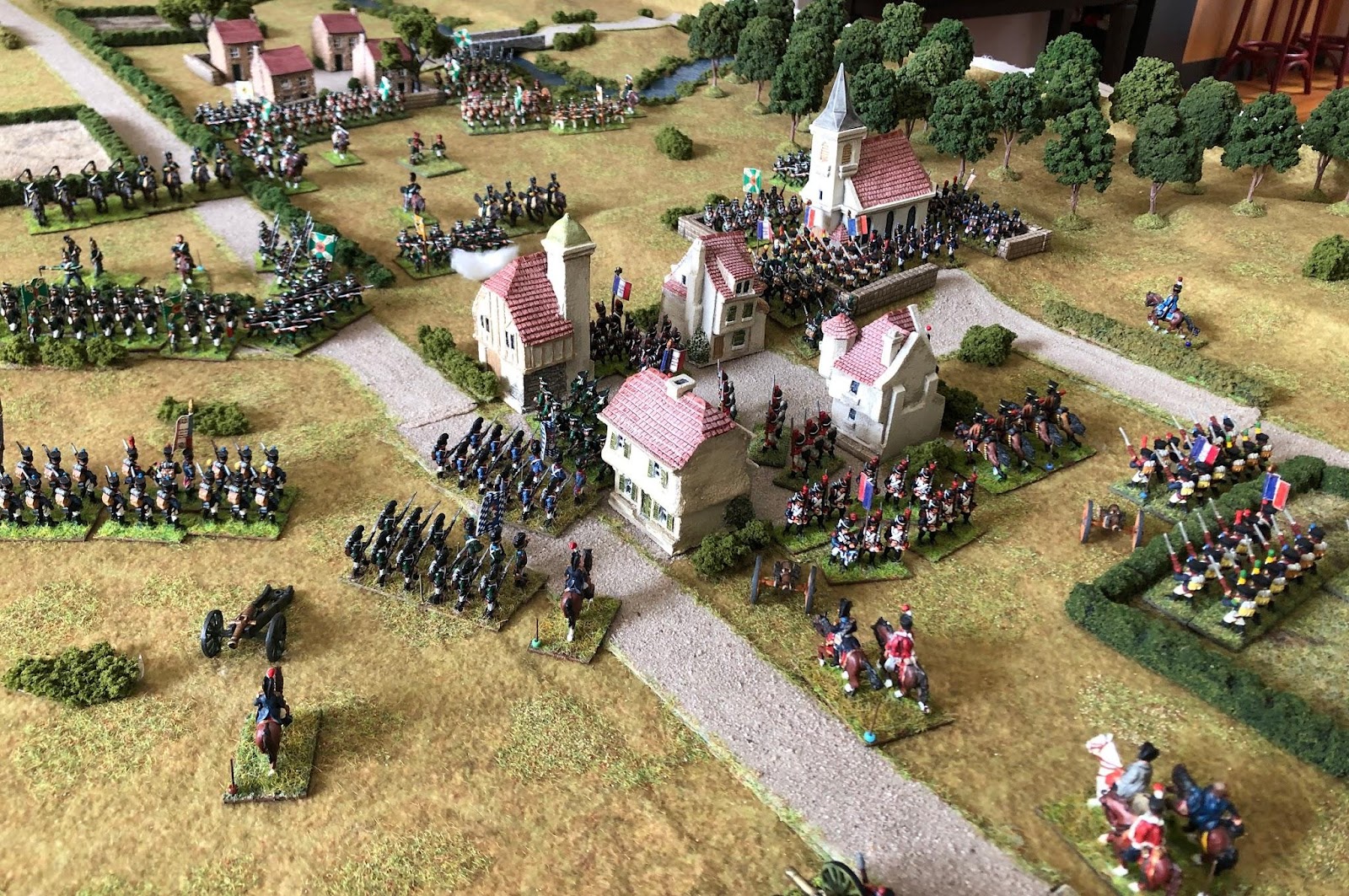
View from the French right flank. The weight of French numbers and quality finally turn the tide in Brienne-le-chateau.
The cavalry melee on the French left continues even in the dark!
Turn 12
The Russians pull their cavalry back after getting the worst of the melee.
The Russian left flank falls back on Brienne-le-veille, but a few regiments continue to hold out in the chateau.
The lone Russian jager regiment continues to hold out in the town but they are doomed to surrender next turn.
Turn 13
Last turn of the game. The Russians have suffered heavy casualties and while still contesting the chateau, they are in no fit state to continue any battle on the next day.
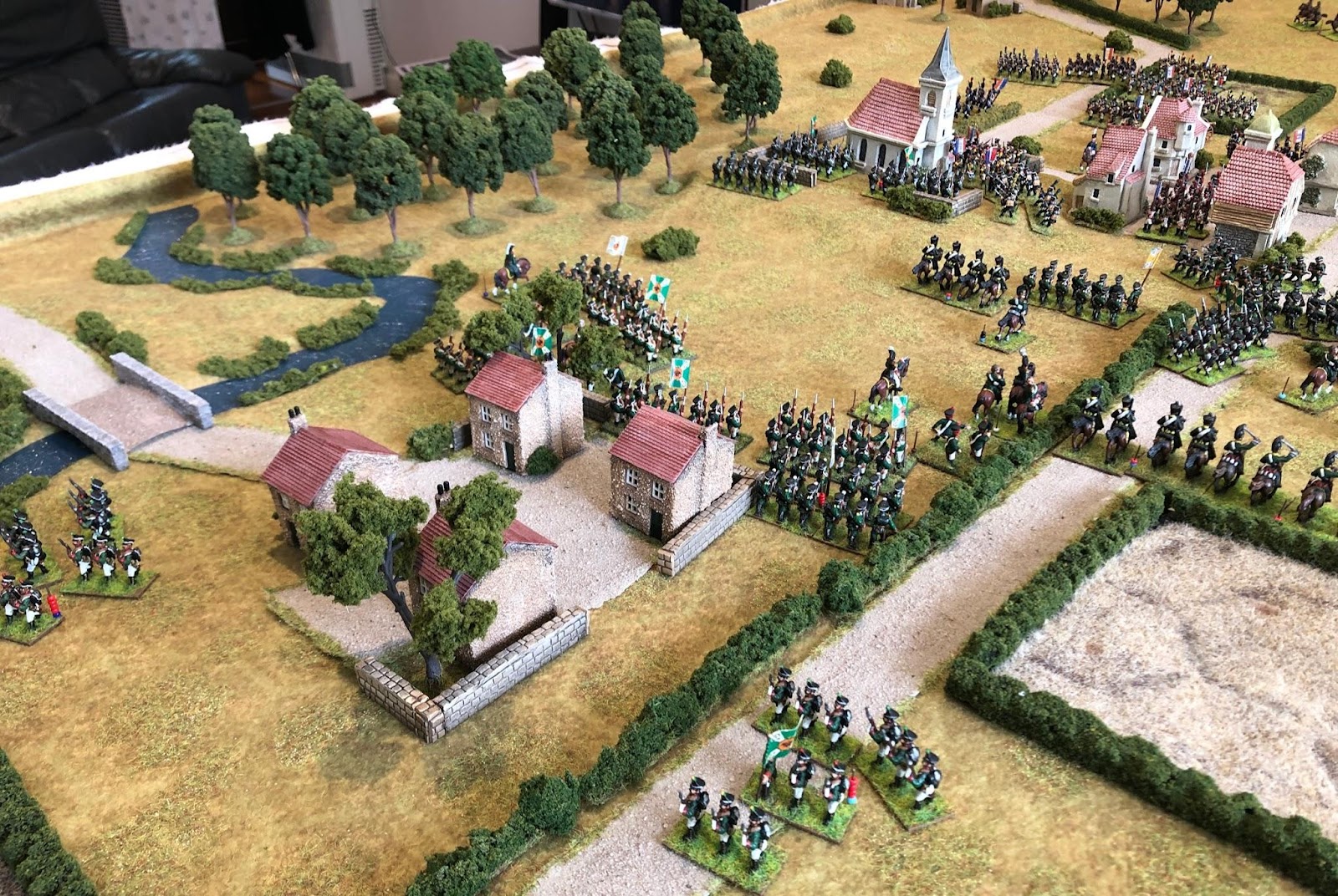
The cavalry melee on the Russian right flank ended with a slight advantage to the French with the Russians conceding ground and suffering many more casualties.

View from the French right flank with the township captured by the Guard and the chateau all but taken. The French also captured 3 of the Russian batteries.

On the French left, brigade makes a final assault on the Russian line and makes a decisive breakthrough. This finishes the Russian resistance and thankfully the darkness allows the Russians to slip away, licking their wounds.
The French ended with a decisive victory, 86 points (1 major objective, 3 guns captured, 2 units destroyed, 51 hits) to the Russians,47 points (1 major objective, 37 hits).

The cavalry melee on the Russian right flank ended with a slight advantage to the French with the Russians conceding ground and suffering many more casualties.
View from the French right flank with the township captured by the Guard and the chateau all but taken. The French also captured 3 of the Russian batteries.
On the French left, brigade makes a final assault on the Russian line and makes a decisive breakthrough. This finishes the Russian resistance and thankfully the darkness allows the Russians to slip away, licking their wounds.
The French ended with a decisive victory, 86 points (1 major objective, 3 guns captured, 2 units destroyed, 51 hits) to the Russians,47 points (1 major objective, 37 hits).

Very nice AAR. What are your roads made with?
ReplyDeleteI used some elastic exercise band material. I chose a beige colour then painted on some gel medium and sprinkled fine ballast onto it. For the road edges, I used gel medium again and sprinkled static grass. It is very flexible and doesn't shed. The roads run easily over hills. In more recent times I've reverted to just pouring ballast directly onto the mat using a 'guide'. This gives more flexibility in placing the roads and I found that a hand vac recovers 95% of the ballast! The Durenstein AAR shows this type of road.
DeleteSuperb looking game.
ReplyDelete